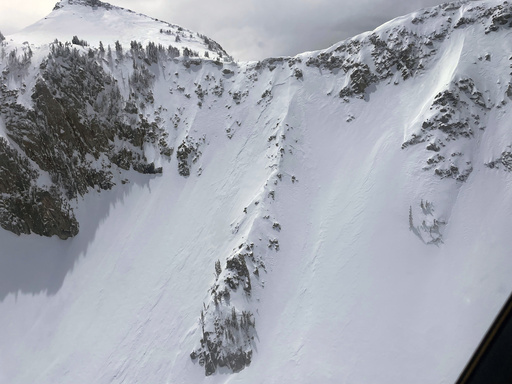SANDY, Utah (AP) — Search crews on Friday recovered the bodies of two backcountry skiers who were swept away and buried by an avalanche in the mountains outside Salt Lake City a day earlier, officials said.
The men — 23-year-old Andrew Cameron of Utah and 32-year-old Austin Mallet of Montana — were killed in the snowslide Thursday morning in the area of Lone Peak in the Wasatch Range southeast of the city. Officials declined to release their hometowns.
Search teams uncovered the men’s bodies Friday morning, Salt Lake County Sheriff Rosie Rivera said. The bodies were brought off the mountain via helicopter and taken to the medical examiner’s office, Sgt. Aymee Race with the Unified Police Salt Lake City said.
Storms on Monday, Tuesday and Wednesday brought up to 3 feet (1 meter) of heavy, wet snow and strong winds to the area.
“And that instantly ramped up the avalanche danger,” said Craig Gordon, an avalanche forecaster with the U.S. Forest Service Utah Avalanche Center.
“The other factor that complicated weather and snow conditions is that it’s spring and weather patterns and weather systems can change very quickly in the mountains,” he said. A day could start off sunny and clear before giving way to clouds or snow or strong winds.
“And all of these factors can influence the dynamic nature of the snowpack and can escalate the avalanche danger,” Gordon said Friday.
The three men were climbing up a ridge on a slope called Big Willow Aprons and were near the top when the slide was unintentionally triggered, the avalanche center said in its preliminary report.
The first climber was carried downhill on the right side of the ridge and partially buried. He was able to dig himself out, call for help and was rescued by midday Thursday. Race said they would not be releasing his name.
Cameron and Mallet were swept away on the left side of the ridge and buried, the center said. Weather and snow conditions prevented their recovery on Thursday.
“We know that’s hard on the families when you have to leave somebody up there,” said Alan Bergstrom, one of eight rescuers who recovered the bodies.
Family members of the two victims were at the search staging area near Sandy on Thursday and Friday, Rivera said.
“There are situations such as today where we may know the people that are on the mountain,” making the recovery effort difficult for searchers as well, said Bergstrom, a squad leader with the Salt Lake County Sheriff’s Search and Rescue team.
Crews “were able to dig pretty quickly and get ’em out and get back on the helicopters,” Bergstrom said. “But as we were finishing up, the winds were picking up and the helicopter was starting to have a little bit of trouble judging the landing spot.”
The three men, who were friends, didn’t plan to ski down the face where the avalanche occurred, but they planned to ski in several other locations on Thursday, Gordon said.
The snow broke about 2 feet (61 centimeters) deep and 250 feet (76 meter) across and slid down about 500 feet (152 meters), the avalanche center said.
The area where the avalanche occurred, Lone Peak, is one of the highest peaks in the Wasatch Range towering over Utah’s capital city. Its steep, rugged terrain makes it a popular destination for advanced backcountry skiers, while experienced climbers scale its sheer granite walls in the warmer months.
“This is very serious terrain. It’s steep. It’s north-facing. The crew that was up there would have to be experienced,” Gordon said Thursday.
Rivera confirmed the men were experienced skiers.
The fatalities bring this winter’s tally of avalanche deaths in the U.S. to 15, according to the Utah Avalanche Information Center. An average of 30 people die in avalanches each year in the U.S.
___
Hanson reported from Helena, Montana.
This website uses cookies so that we can provide you with the best user experience possible. Cookie information is stored in your browser and performs functions such as recognising you when you return to our website and helping our team to understand which sections of the website you find most interesting and useful.
